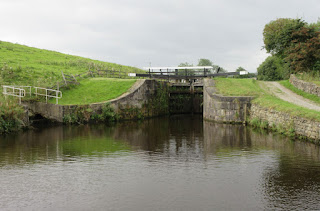Today's Canal - Leeds and Liverpool
Although today was still mainly grey and overcast, some sunshine occasionally broke through and it was much milder than yesterday.
We immediately ascended the last of the Gargrave flight after which we passed over Priest Hole Aqueduct - our last view of the River Aire which has been our companion for a few days.
It was then a short distance to the six locks at Bank Newton. Here we had the assistance of the full time lock keeper. We only saw him to speak to when we reached the top lock as he went ahead to et each lock for us.
One of the locks was renamed (see) in 2016 as the Mike Clarke Lock. He help to found the Leeds and Liverpool Canal Society and has written extensively about the canal's history.
We arrived at the top, chatted to the keeper about how he looks after the water supply and the particular issues arising from the short trip pattern of hire and day boats from Skipton, a usage that is very different from that which the original canal builders envisaged.
The next section is level but very meandering. The hedge line in the distance i where the canal runs after we have been some distance to the right and then back again. We kept seeing the transmitter mast, sometimes to one side and then the other.
One of the first bridges after this section is Double Arched Bridge - no prizes for guessing why it is called that.
The final set of locks to the summit is the flight of three at Greenberfield. This must be the wildest and most remote feeling of all the canal system.
Part way up the flight and a weather forecast : 20% chance of rain! Some spoil sport then found on the internet that the standing or sitting of cows is all a myth. (But it did not rain!)
We had help at the top lock from a volunteer.
There is a service block above the flight - now on the summit level. Also moored here is Kennet, a Leeds and Liverpool short boat built in 1947, the last of this type of boat to be built. It ran until 1960 and in 2011 was converted for use at exhibitions and other events and is operated by the Leeds and Liverpool Canal Society.
We now came down through Barnoldswick, initially passing the Rolls Royce factory where the RB211 engine was developed. There was no indication save for this tiny warning notice.
Several manufacturing activities still remain alongside the canal. Esse proudly claim that they are a Master Stove Maker since 1854 and still produce an upmarket series of cooking and heating ranges.
We then passed back out into another rural stretch with some fine views of the distant hills.
Bridge 149 has a sign (if you can see it behinds the vegetation) that says Welcome to Lancashire.
We delayed out lunch until we arrived at Foulridge Tunnel as we knew that timed entry is only permitted on the hour for ten minutes. As we arrived the person on the one boat already waiting came to ask about when they would be allowed through. They did not know about the times and were a but miffed that the details were not on the tunnel signs! Even the latest addition of his canal guide did not say - however ours does!
The tunnel is about a mile and a short distance afterwards we began the long descent from the summit pound with the seven locks in the Barrowford flight. By now a strong breeze had picked up and the first few locks are quite exposed making waiting between them a bit tricky.
Close to Function 13 on the nearby motorway we knew that there was a Morrisons store as well as a branch of Screwfix. We moored and whilst Mike started to prepare the evening meal, Christine went for milk and a;paper and Andrew bought a new lump hammer to replace the one that went AWOL a few days ago (we do have a second one but it is a bit of a wimp when kit comes to banging in mooring ins in reluctant ground)
We continued to the point where we had identified a probable mooring spot. There are many former mill buildings being renovated for new purposes but the two either side of the bridge just before we stopped caught our attention and we looked up their former purpose. They are all part of the Brierfield Conservation Area. The first was built as Brierfield Mill and in 1838 was the first to bring steam powered cotton milling to the town. Work has started on re-purposing the far end (and splendid it looks) but this end is reminder how the more work still to be done. It was designed to give the impression of wealth.
On the other side of the road, Lob Lane Shed weaving factory built in 1859.The conversion of the main building fronting onto the canal is complete - it is said to be one of the finest examples of the saw tooth design of the roof line.
15.9 Miles - 16 Locks





















No comments:
Post a Comment